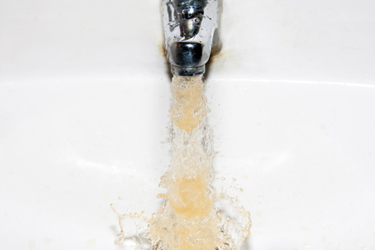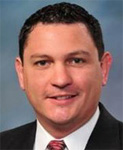5 Strategies To Move Toward A Lead-Free Rural Water System
By Michael Griffiths

Lead service lines are poisoning communities, many of which are already disadvantaged, making it a national emergency that utilities must address with haste. These tips guide the way.
Getting the lead out” is becoming a very slow-moving process when it comes to replacing lead-based water service lines. However, one thing’s certain: Historical lead pipes aren’t doing residents of small American communities any favors. That’s why many utilities and cooperatives are beginning to take steps toward finally ridding their water systems of lead.
Just how large a problem is lead contamination in drinking water across the nation? According to research from the American Bar Association, an estimated 21 million people were exposed to drinking water that held unacceptable amounts of contaminants in 2015 alone — lead was one of those contaminants. Although it would be appealing to assume that the figure is much lower now, not much has changed since then.
There are multiple reasons why many households in small towns haven’t upgraded from aging lead pipes. Most are financial. For instance, homeowners don’t want to have to pay more every month, either to pay for replacements themselves, or to cover “passed on” fees from their water utility providers.
Remember that the average cost of an individual household lead service line replacement can hover just under $5,000. That’s not exactly pocket change to rural residents, many of whom may struggle with financial insecurity.
Utilities don’t want to charge their customers more, either. The last thing a utility wants is to set itself up for the negative press of a significant rate hike. This leaves both parties in tacit agreement to ignore the lead lines.
Another barrier to replacing water lines is that the water itself might taste fine, even though it’s contaminated. Many residents are surprised when they find out that their drinking water exceeds the U.S. EPA’s lead limit of 15 parts per billion. Even then, they may just install water filters as a temporary measure instead of addressing the issue.
Fighting For Water Quality ... and Equality
Despite the obstacles inherent in replacing water lines en masse, communities and the people who live and work in those communities deserve to have clean, potable water. Replacing lines isn’t just a “nice to have” project. It’s a necessary — but fortunately, a one-time — solution that will bring major health benefits to rural Americans.
Many studies have found fault with the EPA’s ruling on “acceptable” lead levels in drinking water, especially for young kids. Poor-quality drinking water that contains lead has been linked to cognitive issues in children.
Is it any wonder that between 2020 and 2021, state legislatures enacted no fewer than 500 bills related to lead in drinking water, mostly focused on children and lead poisoning? The point is that any lead exposure could be bad for the youngest, most vulnerable populations.
So, how can utilities and cooperatives begin moving the needle? Below are five good starting points:
1. Identify how broad-based the problem is.
It’s hard to make any progress without knowing just how big the problem of lead service lines is in any given community. As other communities have done, utilities can create maps of their service line networks. These maps can help identify concentrations of lead pipelines.
Knowing the extent of the issue makes it much easier to tackle. Plus, digital maps can help let consumers and businesses know whether they might be at risk of drinking lead-contaminated water. In Cincinnati, the city’s online and interactive database serves as a single source of lead service line truth for consumers.
2. Inform customers about potential lead pipeline contamination.
The average customer doesn’t think about lead contamination when turning on the tap. Customers need to be educated about what their pipes are constructed of and how those materials can affect their water quality. The more they know, the more likely they’ll want their utilities or cooperatives to help them solve the problem.
Customer education can take many forms, including regularly updated digital portals. For instance, a utility might want to create blog posts about water regulations and standards. A topic, such as a quick overview of the “Revised Lead and Copper Rule” from the EPA, can become the springboard for many pieces of informative content.
3. See how other communities have replaced their lead pipes effectively.
Some communities, utilities, and cooperatives have been very successful in upgrading their water systems. Consequently, other communities should take notice. Building a playbook based on a city or town that has already undertaken the effort can be simpler than starting from scratch.
Some considerations to look for in other communities include how long projects took and how the projects were paid for. Again, every area will have unique needs, but following in other communities’ footsteps makes sense.
4. Look for funding sources.
As mentioned above, any kind of pipe replacement is costly. That’s why it’s important to stay on the leading edge of any funding streams available to cooperatives, utilities, towns, etc. For instance, the EPA has some excellent resources and links to various types of water project grants and loans, such as the Drinking Water State Revolving Loan Fund.
Not all will apply to every community or organization, of course. Nevertheless, some may be able to cover all or a part of replacing lead water lines, while other funds might help cover the cost of educating customers with seminars, workshops, or marketing materials. Cobbling together various money streams can be more pragmatic than hoping to find one single source to pay for everything.
5. Build a framework for replacing all the lead service lines.
With the right information and well-educated customers, utilities and cooperatives can begin building timelines to replace all the lead service lines. This won’t happen overnight. Even incremental improvements can make a huge difference — and they spread out the costs.
In time, the overarching goal can be a lead-free water system. Though some customers might not like absorbing minimal costs along the way, most will appreciate not having to worry about the quality of the water they and their families are drinking.
Lead pipes become ever more hazardous over time. Waiting is riskier than doing something now for the good of rural residents and visitors.
References
- https://www.americanbar.org/groups/crsj/publications/human_rights_magazine_home/vol--44--no-2--housing/rural-america-s-drinking-watercrisis/
- https://www.epa.gov/sites/default/files/2019-10/documents/strategies_to_achieve_full_lead_service_line_replacement_10_09_19.pdf
- https://www.epa.gov/dwreginfo/lead-and-copper-rule
- https://www.science.org/doi/10.1126/sciadv.abn5164
- https://www.ncsl.org/environment-and-natural-resources/state-and-federalefforts-to-address-lead-in-drinking-water#anchor16079
- https://geo.dcwater.com/Lead/
- https://gcww.maps.arcgis.com/apps/webappviewer/index.html?id=0a170c268c694e46a8a4e394630df0bd
- https://www.epa.gov/ground-water-and-drinking-water/revised-lead-andcopper-rule
- https://www.epa.gov/ground-water-and-drinking-water/funding-lead-serviceline-replacement
- https://www.epa.gov/dwsrf/how-drinking-water-state-revolving-fund-works
 About The Author
About The Author
Michael Griffiths is the vice president of the Water and Community Facilities division at CoBank, a national cooperative bank serving vital industries across rural America by providing loans, leases, export financing, and other financial services in all 50 states.
